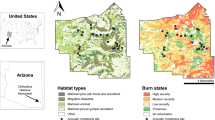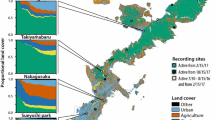Abstract
The biosemiotic complexity of acoustic communities in the primary forests of Ulu Temburong (Brunei, Borneo) and Yasunì (Ecuador, Amazon) was investigated with continuous 24-h recordings, using the acoustic signature and multiscale approach of ecoacoustic events and their emergent fractal dimensions. The 3D recordings used for the analysis were collected in undisturbed primary equatorial forests under the scope of the project, Fragments of Extinction, which produces 3D sound portraits with the highest definition possible using current technologies – a perfect dataset on which to perform a multiscale qualitative analysis. The ecoacoustic events (EEs) detected by a combination of the Acoustic Complexity Indices, ACIft, ACIft evenness, and ACItf evenness, and its fractal dimension were developed according to a biosemiotics approach in which the ecofield theory states that EE functions like a species-specific carrier of meaning. EEs, extracted according to 10 levels of temporal resolution, from 1 to 360 s, confirm the hypothesis that these acoustic communities have an internal complexity that responds to a fractal structure (fractal dimension D of Ulu Temburong D = 1.33 versus Yasunì D = 1.31). Yasunì was richer in EEs, with a higher coefficient of variation of hourly fractal dimension (Yasunì: D = 6.16 versus Ulu Temburong: D = 2.66). This methodology opens up promising new perspectives in the acoustic assessment of habitat quality and monitoring landscape modification. It also confirms the great potential of the biosemiotics approach in converting acoustic frequencies into ecoacoustic events through encoding procedures that mimic potential species-specific interpretations of the sonic environment.




Similar content being viewed by others
References
Ashton, P. S. (2004). Dipterocarpaceae. In E. Soepadmo, L. G. Saw, & R. C. K. Chung (Eds.), Tree Flora of Sabah and Sarawak, volume (pp. 63–388). Kuala Lumpur, Malaysia: Government of Malaysia. ISBN 983-2181-59-3.
Bass M.S., Finer, M., Jenkins, C.N., Kreft, H., Cisneros-Heredia, D.F., McCracken, S.F., et al. (2010). Global Conservation Significance of Ecuador's Yasuní National Park. PlosOne. https://journals.plos.org/plosone/article?id=10.1371/journal.pone.0008767
Blumstein, D. T., Mennill, D. J., Clemins, P., Girod, L., Yao, K., Patricelli, G., & al, (2011). Acoustic monitoring in terrestrial environments using microphone arrays: Applications, technological considerations and prospectus. Journal of Applied Ecology, 48, 758–767.
Burt, J. M., & Vehrencamp, S. L. (2005). Dawn chorus as an interactive communication network. In P. K. McGregor (Ed.), Animal communication networks (pp. 320–341). Cambridge: Cambridge University Press.
Celis-Murillo, A., Deppe, J. L., & Allen, M. F. (2009). Using soundscape recordings to estimate bird species abundance, richness, and composition. Journal of Field Ornithology, 80, 64–78.
Delaval, M., Henry, M., & Charles-Dominique, P. (2005). Interspecific competition and niche partitioning: Example of a neotropical rainforest bat community. Revue d’ Ecologie. Terre et Vie, 6(2), 149–166.
Depraetere, M., Pavoine, S., Jiguet, F., Gasc, A., Duvail, S., & Sueur, J. (2012). Monitoring animal diversity using acoustic indices: Implementation in a temperate woodland. Ecological Indicators, 13, 46–54.
Dominoni, D. M., Greif, S., Nemeth, E., & Brumm, H. (2016). Airport noise predicts song timing of European birds. Ecology and Evolution, 6(17), 6151–6159.
Dorren, L., Berger, F., Imeson, A., Maier, B., & Rey, F. (2004). Integrity, stability and management of protection forests in the European Alps. Forest Ecology and Management, 195, 165–176. https://doi.org/10.1016/j.foreco.2004.02.057.
Eyring, C. F. (1946). Jungle acoustics. The Journal of Acoustical Society of America, 18(2), 257–270.
Farina, A. (2018). Ecoacoustic codes and ecological complexity. BioSystems, 164, 147–154.
Farina, A., & Belgrano, A. (2004). Eco-field: A new paradigm for landscape ecology. Ecological Research, 19, 107–110.
Farina, A., & Belgrano, A. (2006). The eco-field hypothesis: Toward a cognitive landscape. Landscape Ecology, 21, 5–17.
Farina, A., & James, P. (2016). The acoustic communities: Definition, description and ecological role. BioSystems, 147, 11–20.
Farina, A., & Salutari, P. (2016). Applying the ecoacoustic event detection and identification (EEDI) model to the analysis of acoustic complexity. Journal of Mediterranean Ecology, 14, 13–42.
Farina, A., Pieretti, N., Salutari, P., Tognari, E., & Lombardi, A. (2016). The application of the acoustic complexity indices (ACI) to ecoacoustic event detection and identification (EEDI) modeling. Biosemiotics, 9, 227–246.
Farina, A., Gage, S. H., & Salutari, P. (2018). Testing the Ecoacoustics event detection and identification (EEDI) model on Mediterranean soundscapes. Ecological Indicators, 85, 698–715.
Feder, J. (1988). Fractals. New York: Plenum Press.
Ferguson, D. E. (1971). The sensory basis of orientation in amphibians. Annals of New York Academy of Sciences, 188, 30–36. https://doi.org/10.1111/j.1749-6632.1971.tb13087.x.
Frontier, S. (1987). Application of fractal theory to ecology. In S. Legendre & L. Legendre (Eds.), Developments in numerical ecology (pp. 335–378). Nato ASI series, vol. G14. Berlin: Springer-Verlag.
Fuller, R. A., Warren, P. H., & Gaston, K. J. (2007). Daytime noise predicts nocturnal singing in urban robins. Biology Letters, 3, 368–370.
Gage, S. H., Napoletano, B. M., & Cooper, M. C. (2001). Assessment of ecosystem biodiversity by acoustic diversity indices. Journal of the Acoustical Society of America, 109, 2430. https://doi.org/10.1121/1.4744597.
Gil, D., Honarmand, M., Pascual, J., Perez-Mena, E., & Macias Garcia, C. (2014). Birds living near airports advance their dawn chorus and reduce overlap with aircraft noise. Behavioral Ecology, 26, 435–443.
Grafe, T. U., & Keller, A. (2009). A Bornean amphibian hotspot: The lowland mixed dipterocarp rainforest at Ulu Temburong National Park, Brunei Darussalam. Salamandra, 45, 25–38.
Grafe, U., Monacchi, D. (2014). Detailed Species Recognition of a Circadian Hi-definition Recording in a Primary Dipterocarp Forest. Unpublished study.
Griffin, D. R., & Hopkins, C. D. (1974). Sound audible to migrating birds. Animal Behaviour, 22(3), 672–678.
Halley, J. M., Hartley, S., Kallimanis, A. S., Kunin, W. E., Lennon, J. J., & Sgardelis, S. P. (2004). Uses and abuses of fractal methodology in ecology. Ecology Letters, 7, 254–271.
Hastings, H. M., & Sugihara, G. (1993). Fractals. A user's guide for the natural sciences. Oxford: Oxford University Press.
Joo, W., Gage, S. H., & Kasten, E. P. (2011). Analysis and interpretation of variability in soundscapes along an urban-rural gradient. Landscape Urban Planning, 103, 259–276.
Krause, B. L. (1993). The niche hypothesis. Soundscape Newsletter, 6, 6–10.
Krause, B. L. (2012). The great animal orchestra: Finding the origins of music in the world’s wild places. London: Profile Books Limited.
Krause, B., Gage, S. H., & Joo, W. (2011). Measuring and interpreting the temporal variability in the soundscape at four places in Sequoia National Park. Landscape Ecology, 26, 1247–1256.
Lemon, R. E., Struger, J., Lechowicz, M. J., & Norman, R. F. (1981). Song features and singing heights of American warblers. Maximization or optimization of distance. Journal of the Acoustical Society of America, 69, 1169–1176.
Li, J., Du, Q., & Sun, C. (2009). An improved box-counting method for image fractal dimension estimation. Pattern Recognition, 42(11), 2460–2469.
Mandelbrot, B. B. (1983). The fractal geometry of nature. New York: Freeman.
Mazaris, A. D., Kallimanis, A. S., Chatzigianidis, G., Papadimitriou, K., & Pantis, J. D. (2009). Spatiotemporal analysis of an acoustic environment: Interactions between landscape features and sounds. Landscape Ecology, 24, 817–831.
Monacchi, D. (2007). Prima Amazonia - portraits of acoustic biodiversity, Glen Ellen: Wild sanctuary, WSI-056.
Monacchi, D. (2008). Field recording in Dzanga-Sangha, Central African Republic and soundscape design for the film “Oka!” directed by Lavinia currier, Roland Films.
Monacchi, D. (2011). Recording and representation in eco-acoustic composition. In: J. Rudi (Ed.), Soundscape in the Arts (pp. 227–250), OSLO: NOTAM.
Monacchi, D. (2013). Fragments of extinction – An eco-acoustic music project on primary rainforest biodiversity. Leonardo Music Journal, 23(Sound Art)s), 23–25.
Monacchi, D. (2016). A philosophy of eco-acoustics in the interdisciplinary project fragments of extinction. In F. Bianchi & V. J. Manzo (Eds.), Environmental sound artists (pp. 159–168). Oxford: Oxford University Press.
Monacchi, D. (2017). The Sonic Heritage of Ecosystems - Toward a formulation. Proceedings of the SOIMA International Conference Unlocking Sound and Image Heritage, Brussels: ICCROM. ISBN 978–92–9077-264. https://doi.org/10.18146/soima2015
Morley, R. J. (2000). Origin and evolution of tropical rain forests. Chichester: John Wiley and Sons.
Morse, D. R., Lawton, J. H., Dodson, M. M., & Williamson, M. H. (1985). Fractal dimension of vegetation and the distribution of arthropod body lengths. Nature, 314, 731–733.
Morton, E.S. (1970). Ecological sources of selection on avian sounds. Ph.D. diss. Yale University.
Morton, E. (1975). Ecological sources of selection on avian sounds. The American Naturalist, 109(965), 17–34.
Mullet, T. C., Farina, A., & Gage, S. H. (2017). The acoustic habitat hypothesis: An ecoacoustics perspective on species habitat selection. Biosemiotics, 10, 319–336.
Pieretti, N., Farina, A., & Morri, D. (2011). A new methodology to infer the singing activity of an avian community: The acoustic complexity index (ACI). Ecological Indicators, 11, 868–873.
Pieretti, N., Duarte, M.H.L., Sousa-Lima,R.S., Rodrigues, M., Young, R.J., Farina, A. (2015). Determining sampling schemes for passive acoustic studies in different tropical ecosystems. Tropical Conservation Science, 8(1), 215–234.
Pijanowski, B. C., Villanueva-Rivera, L. J., Dumyahn, S. L., Farina, A., Krause, B. L., Napoletano, B. M., Gage, S. H., & Pieretti, N. (2011). Soundscape ecology: The science of sound in the landscape. BioScience, 61, 203–216.
Qi, J., Gage, S. H., Joo, W., Napoletano, B. N., & Biswas, S. (2008). In W. Ji (Ed.), Wetland and water resource modeling and assessment Soundscape characteristics of an environment: A new ecological indicator of ecosystem health (pp. 201–211). New York: CRC Press.
Sinsch, U., Lümkemann, K., Rosar, K., Schwarz, C., & Dehling, M. (2012). Acoustic niche partitioning in an anuran community inhabiting an Afromontane wetland (Butare, Rwanda). African Zoology, 47(1), 60–73. https://doi.org/10.1080/15627020.2012.11407524.
Sugihara, G., & May, R. M. (1990). Applications of fractals in ecology. TREE, 5, 79–86.
Tolimieri, N., Jeffs, A., & Montgomery, J. C. (2000). Ambient sound as a cue for navigation by the pelagic larvae of reef fishes. Marine Ecology Progress Series, 207, 219–224.
Tucker, D., Gage, S. H., Williamson, I., & Fuller, S. (2014). Linking ecological condition and the soundscape in fragmented Australian forests. Landscape Ecology, 29(4), 745–758.
Ward, P., & Zahavi, A. (1972). The importance of certain assemblages of birds as “information-centres” for food-finding. Ibis, 115, 517–534.
Author information
Authors and Affiliations
Corresponding author
Additional information
Publisher’s Note
Springer Nature remains neutral with regard to jurisdictional claims in published maps and institutional affiliations.
Electronic supplementary material
Fig. 1
Acoustic signature (ACItf) from Ulu Temburong (A) and Yasunì (B) along daily hours (in x axis the frequency bins are indicated). The absolute value of ACItf is reported in the y axis. (PNG 27102 kb)
Fig. 2
EE similarity of each daily hour according to ten levels of temporal resolution (from 1 to 360 s) in Ulu Temburong (A) and Yasunì (B) study sites (Ward’s method and Euclidean distance). (PNG 1928 kb)
Rights and permissions
About this article
Cite this article
Monacchi, D., Farina, A. A Multiscale Approach to Investigate the Biosemiotic Complexity of Two Acoustic Communities in Primary Forests with High Ecosystem Integrity Recorded with 3D Sound Technologies. Biosemiotics 12, 329–347 (2019). https://doi.org/10.1007/s12304-019-09361-z
Received:
Accepted:
Published:
Issue Date:
DOI: https://doi.org/10.1007/s12304-019-09361-z




